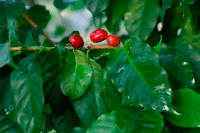

Coffea arabica is a species of coffee indigenous to Ethiopia and Yemen. It is also known as the "coffee shrub of Arabia", "mountain coffee" or "arabica coffee". Coffea arabica is believed to be the first species of coffee to be cultivated, being grown in southwest Arabia for well over 1,000 years. It is considered to produce better coffee than the other major commercially grown coffee species, Coffea canephora (robusta). Arabica contains less caffeine than any other commercially cultivated species of coffee. Wild plants grow to between 7-12 m tall, and have an open branching system; the leaves are opposite, simple elliptic-ovate to oblong, 6-12 cm long and 4-8 cm broad, glossy dark green. The flowers are produced in axillary clusters, each flower white, and 1-1.5 cm diameter. The fruit is a berry 10-15 mm long, maturing bright red to purple, containing two seeds (the coffee 'bean').
Coffea arabica takes about seven years to mature fully and does best with 1-1.5 meters (about 40-59 inches) of rain, evenly distributed throughout the year. It is usually cultivated between 1,300 and 1,500 m altitude, but there are plantations as low as sea level and as high as 2,800 m. The plant can tolerate low temperatures, but not frost, and it does best when the temperature hovers around 20°C (68°F). Commercial cultivars mostly only grow to about 5 m, and are frequently trimmed as low as 2 m to facilitate harvesting. Unlike Coffea canephora (robusta), Coffea arabica prefers to be grown in light shade.
 Three to four years after planting coffea arabica produces small, white and highly fragrant flowers. The sweet fragrance resembles the sweet smell of jasmine flowers. The flowers that open on sunny days produce the greatest numbers of berries. This can be a curse however as coffee plants tend to produce too many berries; this can lead to an inferior harvest and even damage yield in the following years as the plant will favor the ripening of berries to the detriment of its own health. On well kept planatations this is prevented by pruning the tree.
Three to four years after planting coffea arabica produces small, white and highly fragrant flowers. The sweet fragrance resembles the sweet smell of jasmine flowers. The flowers that open on sunny days produce the greatest numbers of berries. This can be a curse however as coffee plants tend to produce too many berries; this can lead to an inferior harvest and even damage yield in the following years as the plant will favor the ripening of berries to the detriment of its own health. On well kept planatations this is prevented by pruning the tree.
The flowers themselves only last a few days leaving behind only the thick dark green leaves. The drupes, or berries, then begin to appear. These are as dark green as the foliage, until they begin to ripen, at first to yellow and then light red and finally darkening to a glossy deep red. At this point they are called 'cherries' and are ready for picking. The berries are oblong and about 1 cm long.
Inferior coffee results from picking them too early or too late, so many are picked by hand, though they are sometimes shaken off the tree onto mats. The trees are difficult to cultivate and each tree can produce anywhere from 0.5-5 kg of dried beans, depending on the tree's individual character and the climate that season.
Image and Inforamation Sources: Bio-Gaetner and Wikipedia
The Plant
The Plant Overview | Plant Growth | Arabica vs Robusta
Robusta Coffee |
Arabica Varietals | Growing Coffee at Home



















































